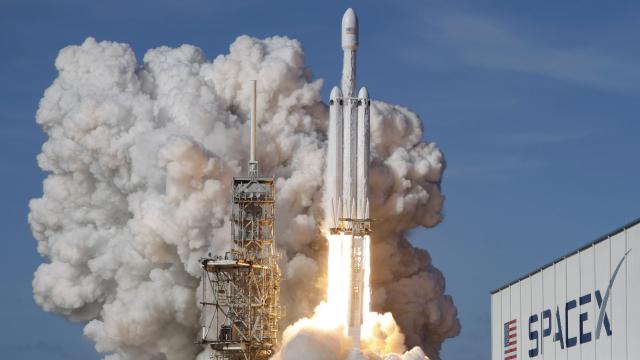SpaceX’s Falcon Heavy launch went pretty well today, with the rocket’s two partially reusable Falcon 9 strap-on boosters making successful landings at Kennedy Air Force Station after jettisoning from the craft three minutes post-launch. However, the rocket’s center core did not function as founder Elon Musk and team intended, and appears to have later crashed back down to Earth. Hard.
Per the Verge, after breaking away from its upper stage (the portion of the Falcon Heavy carrying its Tesla Roadster payload), the core experienced engine problems. It didn’t quite miss the remotely piloted ship where it was supposed to land, exactly, but neither the core or the ship survived intact:
The center core was only able to relight one of the three engines necessary to land, and so it hit the water at 483km per hour. Two engines on the drone ship were taken out when it crashed, SpaceX CEO Elon Musk said in a press call after the rocket launch.
Audio: “We lost the center core” #FalconHeavy @SpaceX pic.twitter.com/OaJhMa7f2U
— Drew King (@King_Drew16) February 6, 2018
According to Engadget, Musk said the core landed some 100 meters from the ship but that a massive spray of shrapnel did indeed make contact. There apparently may be video of the crash, but Musk said that depends on if “the cameras didn’t get blown up as well.”
Sounds like the core is scrap at the bottom of the ocean. That’s certainly not ideal, but it’s also a relatively minor mishap given the Falcon Heavy set history as the most powerful rocket currently in operation and successfully sent the Roadster on its path towards the rest of the solar system. Plenty of rockets exploded or slammed into the ground on SpaceX’s path to today, and it’s likely they will continue to do so as Musk and team continue development.
Regardless of the fate of the last rocket section, the launch demonstrates the Falcon Heavy can successfully deliver a payload instead of breaking up due to “unanticipated vibrational resonances,” which is what matters to paying customers. According to Space.com, SpaceX already has two commercial launches using the rocket scheduled for 2018, the Arabsat 6A communications satellite and a U.S. Air Force mission which will also carry a solar-sail experiment. As TechCrunch noted, the end goal is for Musk’s company to be able to “turn rockets around in less than 24 hours and have reflown boosters go up twice in one day.”
According to Musk, his Roadster is well on track to exceed Mars orbit and will come close to the orbit of the minor planet Ceres in the asteroid belt, where it could potentially orbit for hundreds of millions of years barring a collision with another spaceborne object.
Third burn successful. Exceeded Mars orbit and kept going to the Asteroid Belt. pic.twitter.com/bKhRN73WHF
— Elon Musk (@elonmusk) February 7, 2018
